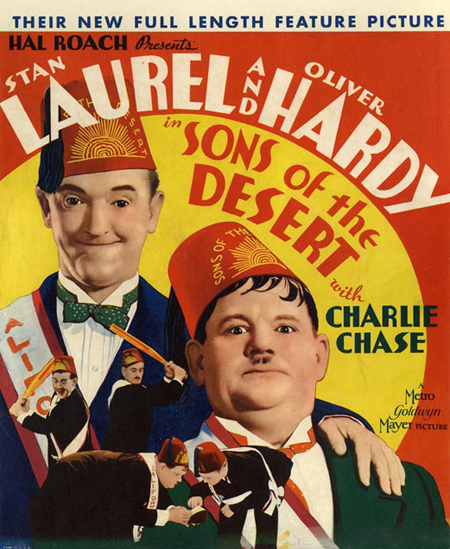

None of this, as you are correctly thinking, goes according to plan. So Stan and Oliver hatch a scheme that includes a doctor (Lucien Littlefield), a fake ailment, and a Honolulu cruise. And to everyone’s surprise, Oliver’s wife Lottie (Mae Busch) also disallows her husband to attend the Sons of the Desert convention. To no one except Oliver’s surprise, Lottie refuses to allow Stan to attend the convention. Oliver rolls his eyes, saying that Stan has taken, “a sacred oath”, and that sacred oaths must be upheld. The reason for Stan’s hesitance is his well-founded belief that his wife, Betty (Dorothy Christy), is certain to say that he cannot attend the convention. All members take an oath that they will attend (to which Oliver forces a hesitant Stan to do so). Stan and Oliver belong to a California branch of Sons of the Desert, and the upcoming annual convention will be held in Chicago. The Sons of the Desert wear fezzes, take oaths, eat and drink, play pranks on each other, and little else from what yours truly can ascertain. Stanley (Laurel) and Oliver (Hardy) are members of a fraternity named Sons of the Desert. – combining silent-era slapstick with situational humor made even more hilarious thanks to the relationship they have perfected between their characters. An ideal entry into 1920s and ‘30s Hollywood comedy, Sons of the Desert is a testament to Laurel and Hardy’s hilarity It is the only time Seiter and the duo worked together. Seiter and as Laurel and Hardy’s fourth feature-length film, Sons of the Desert represents a pinnacle of comedic filmmaking. Any longer and the film would become wearisome. Roach realized that he could muster just enough comedic material from a Laurel and Hardy film’s main concept to last just over an hour. Laurel and Hardy’s partnership with Metro-Goldwyn-Mayer (MGM) producer Hal Roach – who specialized on comedic short films – extended into creating feature-length films. Laurel became a quiet, wide-eyed fellow always reacting to what terrible things happen to him where Hardy tackles the problems head-on, rolling his eyes at the wise guys who make fun of him and his partner. As they began to work together, they refined their roles. Stan Laurel, Charlie Chaplin’s former understudy, began his career with characters that were smiling mischief-makers for Hardy, he mostly played background characters or pompous comedic villains. This also meant altering their on-screen personas before linking up as a comedic duo. Their sense of humor remained visual but, unlike the many silent film comedians attempting to reinvent themselves to the ever-shifting demands of moviegoers, they placed little emphasis on the sound of their own voices.

And though the team of Stan Laurel and Oliver Hardy began their careers just before the introduction of talkies in 1927, they were one of the few silent film comedians to survive that transition.

VILLAINS IN LAUREL AND HARDY MOVIES MOVIE
Not many movie comedians survived the transition from silent film to synchronized sound.


 0 kommentar(er)
0 kommentar(er)
